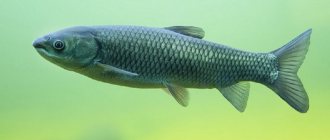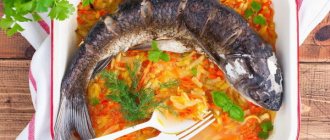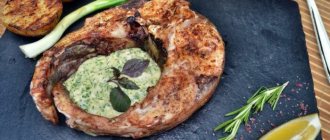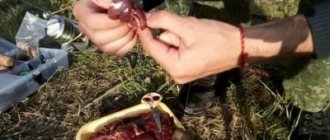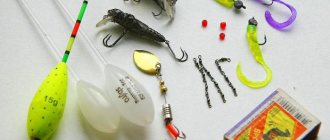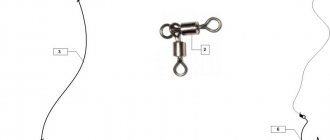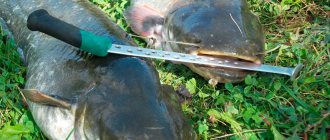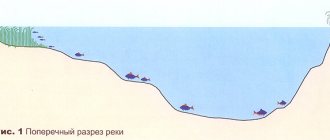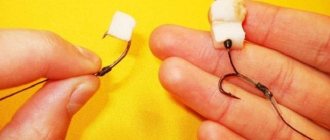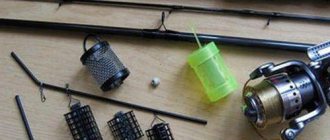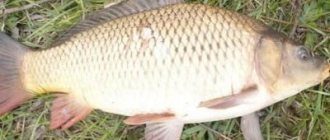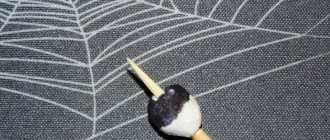TOP popular products for fishing
— buy with good discounts for personal use and as a gift to friends and acquaintances.
Buy quality products at affordable prices in the best fishing online stores
. Give gifts to yourself and your loved ones!
we are in social networks
— subscribe to us on Facebook, Youtube, VKontakte and Instagram. Stay up to date with the latest site news.
Probably every angler wants to catch grass carp using amateur gear. This fish is good because it can be caught all summer and equally well with different gear. Bottom gear for catching grass carp is effective from the beginning of May until the end of October.
In terms of strength, cupid is not inferior, and in some cases even superior to carp. Given this aspect, the angler must pay special attention to the strength of his gear. Let them be rough and not very beautiful, but reliable and durable.
Grass carp has very tasty and tender meat. It can be used during diets. Many delicious dishes come from cupid.
Finding a place to fish for white carp with a donkey
Grass carp are caught very well on a donk if you cast them not into holes, but into smaller areas. This factor determines the fishing distance. It usually does not exceed 35-40 meters. Moreover, the cupid takes the bait not from the bottom, but a little higher. If bream and carp constantly feed at the bottom, and their mouths vacuum the bottom, then cupid always looks straight and does not like to bend over.
The main condition for the presence of carp in a reservoir is the presence of algae and coastal vegetation. If there are a lot of these components, then cupid will be caught well.
Bait for grass carp
Grass carp baiting is a perennial topic and, to be honest, there are so many to choose from. The main problem is that in each reservoir, grass carp have their own preferences and the choice of bait depends on the fishing location. Precisely because in one body of water cupid prefers one bait or another, while in another it never bites and there are different opinions. Some say that the best bait for cupid is a cucumber, others say that cupid will never take a cucumber. And all because these fishermen fish in different bodies of water.
If you don’t yet know what kind of bait will be interesting to the carp in your pond, then you will have to experiment, offering the fish a variety of bait, which can be quite ordinary, or maybe surprise the fisherman. Tell me, how many fishermen have caught fish with cucumber? But in many reservoirs, cupid is great at catching cucumbers, and often only large ones!
This is the bait you can use when catching grass carp on a donk:
- cucumber;
- reed;
- seaweed;
- boilies;
- corn;
- muckworm;
- crawl out;
- maggot;
- cabbage, etc.
All of these baits are effective, but in any case, the most effective one should be selected for each body of water. Moreover, it is not always possible to do this on the first fishing trip. Be patient, find the right bait and then you will be able to regularly catch grass carp on a donk.
Lures and baits for catching grass carp on a donk
To catch grass carp, you need to feed it well. You can simply bring the bait on the boat and pour it out of half a bucket. During the fishing process, the remaining half can be thrown with a slingshot or by hand. Yes, you will need at least a bucket of bait. The main components: cereals, flour, mixed feed, as well as store-bought mixtures.
Grass carp loves grass and is attracted to the spam smell. Therefore, cucumber and cane dips are added to the bait. You can get a little creative and add natural flavors. Take a couple of cucumbers plus watermelon rinds plus some pulp. Grind all this into a pulp in a meat grinder and add to the bait. The result will be a stunning aroma that should attract cupid.
In general, you need to understand that aromatics play a very important role in bait for grass carp. To keep him on the spot, you need not only coarse bait, but also smell. Geyser bait is often used on paid reservoirs. It dusts well and works well in stagnant bodies of water.
To understand how to catch carp on a donk, it is not enough to use a large amount of bait. It is important to place a bait on the hook that will look like something from the already baited bait. An excellent bait is canned corn. The grains should be large and not empty inside. Fresh peas also work well. When it is still green, it has a very pleasant aroma. In addition, the peas stay on the hook very well.
You can also catch grass carp using boilies. Carp with herbal aromas are suitable. Since the carp is active in the water column, foam is placed on the hook. He lifts the bait by the length of the leash, and the fish actively swallows the hook.
Catching grass carp with peas
This bait is not very common, as it is only used when the peas are ripening. But in some regions it is simply irreplaceable when catching grass carp, which is a vegetarian. The bait used is soft pods in which small peas have just appeared, which hold well on the hook, have a bright color and a pleasant smell, which certainly attracts fish.
Also, when fishing, the entire pea pod can be used, which is attached by several punctures and stitching with fishing line. When using a pea pod for fishing, it is best to leave a small stalk with leaves and tendrils, this way it attracts fish more and looks more convincing.
Bottom rigs for fishing grass carp
How to catch cupid with a donk? The most catchy rig for carp is the zig rig.
There are two modifications of the zig rig. The most popular for cupid using a long leash made of fluorocarbon fishing line. The length of the leash varies depending on how far from the bottom the hook with the foam should be.
You can use a fixed zig rig with a running clip, in which the weight is released when fishing on snags or a littered bottom.
Another effective equipment is with a method feeder, or spring. A leash with a hook is attached to the feeder. Styrofoam with corn or dough is hung on hooks. Grass carp will be caught well on a donkey if you fill the spring with porridge rich in nutrients. It is important that when casting, the hook with the nozzle does not get stuck in the algae, but rises. In this case, it will be noticeable to fish. Before casting, you should check the bottom to make sure it is free of vegetation. In some cases, if the fishing distance is short, it makes sense to clear the bottom with a rake or scythe.
Catching grass carp on a donk
Donka for white carp is considered the main and most effective method of catching this powerful and large fish. The most effective equipment for catching carp is the zig rig. There are 2 modifications of it, the most popular one uses a long leash made of fluorocarbon fishing line, the length of which varies depending on the distance from the bottom of the hook with foam.
You can also use a fixed zig rig with a running clip. Also a good equipment is a feeder or spring filled with porridge.
It is important that when casting the hook does not get stuck in the algae, so you need to check the bottom for vegetation in advance.
Grass carp is best caught in small areas, excluding holes, and it takes the bait not from the bottom, but a little higher.
Fishing rods and other equipment for bottom fishing for carp
The best answer to the question of how to catch grass carp on a donk is from professional carp fishermen. Tackle for catching carp and grass carp are similar in many ways. Therefore, it will not be a mistake if you use carp rods, reels and bite alarms. In addition, the method feeder and hair rig used for catching carp will be appropriate when fishing for carp.
The rod should be powerful and hold the fish well. It is desirable that the rings have a large diameter for better line movement between them. The reel is used with spools from 5000 to 8000. Grass carp can be caught well on a donkey if you use thick fishing line with a diameter of 0.35 mm. A fence is placed if the fishing distance exceeds 40 meters. But in general, you can get by with fishing line. Rodpods with signaling devices or ordinary stags are used as stands.
ribalka-vsem.ru
Float tackle for catching grass carp
Float equipment for catching grass carp can be assembled in a similar way - see the picture.
The configuration of the medium size carp boilie hook allows you to put two medium foam balls and three kernels of corn on the hook.
You can experiment with the attachment in different ways: corn - foam ball - corn or corn - ball - canned green peas - ball - corn. There were bites for all options, there were almost no gatherings.
Rod for catching grass carp
Rods for catching grass carp need powerful ones, with a test weight of 50-80 g; you can use a heavy feeder for the river, carp and spinning rods.
The main fishing line for catching grass carp is taken with a diameter of 0.3-0.35 mm, the leashes are made of 0.2 mm braided cord. The length of the leash depends on the height of the grass layer. It is necessary to calculate so that when the tackle is released, the nozzle on the leash is located above the grass.
The secret weapon for catching grass carp
The most common dill is the “secret weapon” for catching grass carp.
First you need to cut the fresh aromatic dill into small pieces. Then you need to grind the dill in a mortar so that the juice comes out.
Now you need to mix the chopped dill with pre-boiled hard corn.
Let the resulting mixture sit overnight before you go fishing and attach the resulting carp treat to your hair rig.
Using a rig with a sinker on the side leash, you will get an excellent bite alarm.
master-fisher.ru
Equipment for catching grass carp using a feeder and a float rod
What to use to catch grass carp? Catching grass carp can be done using a variety of gear. And if you take into account the seasonal characteristics of the behavior of grass carp, you can get quite decent results. Fishing for white carp can be successful with both bottom tackle and a float rod.
Catching grass carp on a feeder
It is best to catch grass carp on a feeder in the spring, before the bottom grass has grown, or in reservoirs with sparse bottom vegetation, or choose windows for casting bait. Grass carp will certainly be tempted by corn or encroach on floating boilies. It is better to raise the bait a little higher than the bottom. Small white cupids will not refuse maggots or worms, despite their vegetarianism. In summer, catching carp on a feeder is not very effective, but it is possible - it depends on the reservoir.
Catching grass carp with a float rod
An excellent bait for catching grass carp on a float rod are tiny cucumbers, or rather not the cucumbers themselves, but their ovaries. Fleshy aloe leaves without thorns and bunches of algae, which are best pre-moistened in flavorings, are also perfect as bait. Cupid will not refuse pearl barley, peas or corn. In any case, vegetable baits should be soft and as gentle as possible.
Features of catching grass carp
Initially, this fish was very difficult to catch because of its nutritional base, which consisted of aquatic vegetation, but over time, grass carp began to feed on other types of food offered to it and it began to be caught using baits traditional for anglers. Active biting of carp can be observed in the morning and evening hours, but sometimes, for some reasons, it becomes active in broad daylight. Grass carp are frightened by unnecessary noise on the shore, so you should prepare quite seriously for its capture. If there is food in the reservoir, this fish is unlikely to pay attention to anglers’ baits.
Some fishermen resort to some tricks to lure grass carp:
- Throw bait in the immediate vicinity of the thickets.
- They independently clean part of the reservoir, making original windows.
- Fishing is carried out at night, when there is a minimum of noise, near a reservoir.
- They bait grass carp for several days before fishing.
The best times for fishing for grass carp are considered to be warm, cloudless days without wind.
Bottom equipment for catching grass carp
A sinker is not used in the rig; hominy (the size of a fist) is hammered into the spring, the mass of which was sufficient for casting.
On the hook is a hair rig with several kernels of canned corn and a foam ball.
Always check whether the hook floats or sinks before casting. If it sank, then the number of grains on the hair was reduced or polystyrene foam was added. After several successful fishing trips, we encountered some inconveniences:
- the equipment sometimes got tangled when casting, and there were no bites - solution: overlaps can be partially dealt with by making more accurate and soft casts
- The carp hook was too thick and heavy, so I had to put on a lot of foam balls - the solution was to change the hook to a thinner one (hooks made of thin hardened wire for boilie equipment turned out to be ideal).
- fish often disappear at the moment of hooking - the reason for frequent disappearances is that the cupid does not reach the hook, sucking in the hair with the nozzle - solution: place corn and foam balls directly on the hook.
Selection of tackle and accessories
For catching such powerful fish, ordinary and familiar gear is not suitable, since they cannot withstand the resistance of grass carp.
The main gear for catching grass carp are:
Plug
This is a long rod, reaching a length of about 13 meters, capable of withstanding the force of fishing for large specimens. The most important advantage of such a fishing rod is its durability. The gear used imitates a free-falling bait in the water column, which works very well to attract grass carp. The basis of a plug fishing rod is: rubber, length from 1.4 to 2.1 m, fishing line, diameter from 0.14 to 0.22 mm and a hook No. 10 attached to the fishing line.
Match fishing rod
A fishing rod of at least 4 m in length is selected. It is also possible to use shorter forms: it all depends on the fishing conditions, the main thing is that it is durable. As a rule, for catching grass carp, standard carp rods are selected, equipped with powerful reels for catching large specimens. The fishing line is selected with a thickness of about 0.4 mm, and a rigid cord is used as a leash.
Feeder
Feeder gear is used for catching grass carp in the spring, when there is still no green vegetation at the bottom of the reservoir. The length of the feeder can be within 4 meters and it is equipped with a reel of size 3500. A monofilament line with a diameter of 0.3 mm is installed on the feeder, as well as braided leashes, the length of which is selected experimentally. When catching this fish, it is very important that the bait is raised above the bottom level to 20 cm.
Methods of catching grass carp
Being a very sensitive and shy fish, cupid avoids the open coastline. Where there is free access to water, there is a crossing or a ferry, a busy pier - there is nothing for a fisherman who has decided to hunt for our Far Eastern guest. Do you want to catch cupid? Be prepared for various difficulties and obstacles! Overgrown and swampy shores, tangled stems of algae on the bottom and other unpleasant conditions for fishing await you.
These troubles are compensated by a wide selection of reservoirs for fishing: carp are released into lakes, into excavations from dredgers, into canals for irrigating fields, and even into any flooded quarry. And this is in addition to natural reservoirs. You can catch carp at any time of the day, except at night. It is preferable to go fishing on a windless and sunny day, so carefully follow the meteorological reports, otherwise you risk simply wasting your time and ruining your mood for a long time. You can also use a feeder for long casts.
Most often, cupid is caught on a float rod, well known to every fisherman, similar to the one that amateurs use for carp fishing. However, it must be taken into account that cupid can significantly exceed carp in weight and size. The maximum weight of this fish can reach up to 32 kilograms, and the length can be up to one meter. And although such specimens are extremely rare, the tackle for catching carp needs to be selected more powerful than the one you are used to usually using.
Catching carp with a spinning rod
Cupid is caught using a spinning rod, most often in reservoirs with rich vegetation, where the fish feels at ease and well-fed. The rod for spinning is chosen the same as for carp fishing. The choice of spinning reel depends on the thickness of the fishing line. Most often, a fishing line with a diameter of six or seven tenths of a millimeter is used to catch grass carp.
The hook should be used corresponding to the other tackle - No. 9 is quite suitable. As already mentioned, cupid is an exclusively herbivorous fish. This determines the composition of the bait. Most fishermen use algae shoots, young corn stalks, small cucumbers and even pieces of indoor aloe for this purpose.
However, in some reservoirs, carp also bite well on traditional carp bait: corn, pearl barley or boiled potatoes. In both cases, the point of the hook must be hidden behind the bait. Otherwise, the fish will get pricked, get scared and may leave the fishing spot.
Catching carp with a fishing rod
If you decide to fish for carp with a float rod, remember that a regular fly rod is not very suitable for this purpose. It should be understood that cupid, which has impressive dimensions, requires shock-absorbing components in the fishing gear. The fly rod most likely will not withstand such a load - there is a very high probability of breakage. When going fishing for grass carp, you should give preference to the match or plug method of catching this fish. There is no fundamental difference in the effectiveness of both methods; the main thing is patience, experience and the individual preferences of each fisherman.
When choosing fishing rods, you can completely rely on your experience in carp fishing. The habits of cupid are very similar to the behavior of the indigenous inhabitants of our reservoirs. And since the habits are similar, it means that the fishing methods also have a lot in common. Bait will never be superfluous, fortunately you don’t have to prepare it yourself; you can buy it ready-made in the store.
Poaching
Since 1989, fishing with nets has been allowed in many regions of our country. Of course, this method of fishing has a number of strict rules and legal restrictions. Before you start catching carp using a net, make sure that your gear meets fisheries inspection standards, and that the body of water where you are going to fish is not the habitat of rare and protected species.
Read more:
Catching chub with a bombard
A net that is usually placed on carp is excellent for catching carp. As a rule, this is bottom tackle, about two meters high, made of thin and strong thread.
Despite the apparent ease and effectiveness of this fishing method, preference should be given to spinning fishing. After all, fishing is not just a craft and an entertaining pastime. Fishing is also one of the oldest ways to feel oneness with nature, which requires respect and careful treatment.
Note to the fisherman! Whatever gear you choose for catching carp, always try to provide an excess safety margin. Grass carp average over four kilograms in weight and grow very quickly. If the living conditions in the reservoir are favorable, then you may well encounter specimens weighing more than fifteen or even more than twenty kilograms. Don't miss out on this kind of loot because of your negligence.
Best bait
Initially, grass carp were caught on:
- cabbage leaf;
- green cucumber slices;
- dandelion leaves and stems;
- green pea or bean pods;
- various algae.
Such baits are still promising in our time, but the fish have become accustomed to new bodies of water and are not against trying baits such as:
- worm;
- bloodworm;
- crawling out;
- maggot.
At the same time, grass carp does not refuse peas, corn, wheat, etc. Given its varied preferences for different types of food, it is sometimes very difficult to choose an effective bait or bait. Therefore, when going fishing, it is better to take several types of baits with you and calculate the preference of grass carp, one by one sending them into the pond.
Some fishermen use tiger nuts to catch grass carp. This bait has a peculiar aroma that quickly spreads in the water and lures fish.
To prepare nuts, you need:
- Boil them in water for 1 hour.
- After finishing cooking. The nuts are infused in a bowl, wrapped in cloth.
- After cooling, an attractant is added to the mass to enhance the aroma.
- Ready-to-eat nuts are dried in the sun.
Baits of animal origin work well in stocked reservoirs, but traditional baits of plant origin are better used in reservoirs where there is little fish.
Catching grass carp with tiger nuts
Before casting your tackle, try to get the fish accustomed to the bait. Tiger nuts have worked well, just like hard corn. This is most likely due to their specific sweetish aroma. To obtain such a taste, you need to properly prepare this bait:
Initially, tiger nuts are cooked for 30-60 minutes. Then they are kept warm for as long as possible. To enhance the attractive effect of the bait, after the cooking process, a special syrup is added, which has an extraordinary aroma of tiger nuts. After this attractant has been added, it is necessary to place the nuts in the sun and keep them there until they begin to float in the slimy mass. After this, the bait develops a strong aroma and sweet taste. Tiger nuts are recognized as the best bait for catching grass carp in July.
You should not stand on ceremony with the choice and supply of bait. Grass carps do not process food very well: in order to obtain the required energy from food, they need to consume it in large quantities. For this reason, you can safely throw even a few kilograms of bait into the pond - it won’t get any worse. Repeat feeding 2-3 times using a fishing rod, bait rocket or scoop.
It is advisable to start fishing for grass carp in July after the summer heat has subsided. It is best to start fishing in the evening until late morning, without stopping. Also feed without skimping. Don't forget that catching grass carp in July requires care and patience.
If you want to achieve better results, slightly raise the bait with the hook above the mobile bait. Use a snap for this. To provide buoyancy for a bait with a hook, you can make a cavity in it using a drill and plug the resulting hole with a suitable piece of cork.
Tiger nuts prepared as described above have buoyancy that can be compared to small boilies. Place 1-2 of these floating nuts on the hook. You can also make a sandwich using artificial corn and floating nuts. Due to the bright contrast, the bait will be a noticeable irritant that can attract grass carp.
Feeding technique
Grass carp loves corn most of all, so it should be present in all types of bait.
To prepare bait mixtures, the same ingredients are used as for most carp:
- peas;
- Hercules;
- corn grains;
- sunflower cake.
For the most part, grass carp are attracted to the strong aroma of corn, which even the most cautious fish cannot resist. Grass carp eats a lot, so a sufficient amount of bait is required. As a rule, when catching this fish, they do not skimp on bait and pour up to 2 kg of corn into one place. You should not immediately feed the place, but try to catch the fish without bait first and only after a negative result, feed the place.
If you want to catch a large fish, then it is better to cast the tackle a little further than the feeding area, where larger specimens are circling. As a rule, the bite is always better at the fishing point, but smaller individuals are eaten.
Habitats and catches
Starting from a depth of 1 m and ending with depths of 4 m, you can hope for a successful bite of grass carp. Based on the fact that it is bred artificially, it can be found in irrigation canals, reservoirs near thermal power plants, as well as in ponds that require constant cleaning of aquatic vegetation. It can also be found in heavily overgrown lakes and ponds, where there is enough food for it. This fish feels safe near fallen trees, snags and other objects in the water.
Fishing tactics
Of course, not everything is as simple in practice as it sounds in theory. It is especially important to correctly determine the place where the fish stand and feed, the season and time of day for successful fishing. An equally important factor in ensuring rich catch is a thorough knowledge of the habits and disposition of the fish. They catch carp in the summer, starting in late spring, when reservoirs warm up to nineteen degrees above zero. It is worth noting that cupid is generally a heat-loving fish and feels great even at twenty-two degrees Celsius, that is, at a temperature that is uncomfortable for most fish in our latitudes.
It is difficult to find more cautious and timid prey than grass carp. Fishing for this species requires extreme caution and strict silence. Any, even the most insignificant and harmless sound can scare away prey. Cupid reacts sharply to the slightest noise on the shore, be it human steps or the clatter of horse hooves. Cases have been recorded when cupid left the fishing spot due to careless coughing. Bright or colorful clothing of a fisherman can frighten cupid no less than a loud sound. Therefore, do not forget about visual camouflage. Military or hunting camouflage would be quite appropriate. Don't neglect the opportunity to hide behind the branches of a bush.
Read more:
Catching carp
Seasonal bite of grass carp
From late spring to mid-autumn you can safely hunt for this fish.
in spring
During this period, grass carp are caught at moments of slow growth of aquatic vegetation, at water temperatures from +12 to +16C.
In summer
With the onset of real warmth, the bite of grass carp becomes more active, but it is not so easy to catch it, since there is enough natural food in the reservoirs. In the summer, it is very difficult to choose the right bait so that grass carp starts actively biting.
in autumn
This is the best period for hunting grass carp, as the fish senses the coming of winter and begins to stock up on nutrients. During this period, he bites on almost all baits offered to him. It is caught until the water cools down to +10C. In the autumn, the growth of aquatic vegetation stops and there is not enough natural food for it.
in winter
In winter, grass carp stops feeding altogether, staying in deep holes.
fishingday.org
Seasons and grass carp biting
This fish is quite thermophilic, so it begins to actively bite only after the water has warmed up to +13-15°C. At this point, greenery begins to grow rapidly in the reservoirs, which is the main food source for grass carp. As the water temperature increases, its biting becomes more active, which continues until the water in the reservoir cools down to +10°C.
Spring bite of grass carp
Somewhere between mid-April and early May, grass carp begin to bite. During this period, he actively pecks on a worm, fresh greens or bloodworms. For fishing, it is necessary to choose warm, shallow areas, and you should not feed it. During this period, the fish is weakened and does not create much resistance when playing.
Catching grass carp in summer
Summer is the best period for catching grass carp, as well as for other types of fish. Starting from June, you can effectively catch this fish, and starting from July, grass carp begins to really eat. During this period, you can offer him the following attachments of plant origin:
- slices of fresh cucumbers;
- berries or fruits;
- filamentous algae
- corn.
Before the start of spawning, which usually occurs when the water temperature warms up to +25°C, the grass carp bite is constantly improving.
Features of catching grass carp
Cupid and carp have been living together in reservoirs for decades and their habits are similar. But there are also differences. Let's briefly list what you should pay attention to:
Cupid is caught at water temperatures above 12-15 degrees.
Accordingly, depending on the region, the suitable period for flat fishing is from May to October. Moreover, fishing during these border months is the most successful.
The best bite is on clear sunny days, a little worse on cloudy days.
So it is considered. Much depends on the characteristics of the reservoir. Its depth, shape, presence of currents, springs, etc. In practice, carp are also caught in cloudy weather, especially in summer, when the sun disappears for some time and the heat subsides. There is no difference between fishing with bottom gear with a sinker or with a flat, feeder method.
The biting intensity is the same throughout the day and may depend on the current weather.
Since grass carp feeds on vegetation, it is customary to feed it and catch it on flats near the reeds or in areas between underwater plants. But it is not always the case. The fish follows its own “paths” to the feeding places and knowing them, you can successfully feed it. In commercial reservoirs, fish feeding areas are often known, and fish are constantly fed there (by hand, with a slingshot, with a cobra, from a boat...) and caught.
Grass carp is a very careful fish! Many people believe that it is more timid than carp.
This fish is accustomed to swimming in shallow water, rummaging in thickets of underwater grass and reeds, eating their young shoots. It often goes out into water meadows during spring floods and feeds on young grass in the meadows. All this forces Cupid to be constantly on alert - to wait for danger. Any noise or movement means the fish swims to the depths.
On the flat they catch it more often under the opposite shore or at a distance from their shore of at least 70-80 meters.
Although often when fishing for carp, you also come across cupid, and we can say that there is not much difference between them. But that's just how it seems. Grass carp is much more timid, and extremely dislikes noisy companies on the shore.
This fish prefers to swim along its proven “paths”. If you find such a place, then periodic feeding with a flat feeder can keep the fish in place for days.
Catching grass carp on a feeder
The object of fishing can only reproduce in its homeland - on the Amur River and in some of its tributaries. In central Russia the climate is somewhat different. There is no warm running water needed to raise offspring. That is why fishing for carp on the river is considered an unpromising activity, if not hopeless. You need to catch it on stocked fishing grounds and lakes, where the stock is regularly replenished with purchased fry.
On a small body of water, problems with finding a promising place usually do not arise; there are not many of them there. In vast areas the opposite is true. Cupid does not stay in one place, it is in constant search of food and stops only in those areas where there is a lot of food. It would be stupid to chase him around the entire perimeter, so you will have to create a catch point yourself by feeding it correctly. At the same time, you need to understand that the closer to the shore it is, the less frequent and more careful the bites. It is advisable to “set the table” for the vegetarian away from the coastline so that he can grab the bait without any fear. In addition, large specimens are caught far from the shore, while in the coastal zone it is mostly small fish that bite. Trophy fish, of course, also enter shallow water to snack on juicy shoots of reeds, but they behave extremely carefully and at the slightest danger they flee to the depths. Alternatively, you can fish under the opposite bank, if the width of the reservoir and the range of the gear allow. The main thing is that there are no noisy colleagues on the other side.
Lure
The bait should be fine-grained and light, creating a lot of turbidity. Cupid will definitely come to look at this cloud and it is quite possible that he will be attracted by bait or plant bait. By the way, about bait. This topic causes constant controversy. It seems like there is plenty to choose from, starting with a worm and ending with cabbage leaves, but the results are not always pleasing.
The reason for the poor bite or lack thereof is that in each individual body of water the carp has its own taste preferences.
Hence the different opinions of fishermen: some say that it is necessary to fish with algae, while others assure that nothing is better than a young cucumber. If the lake is unfamiliar, you should take with you more different “dishes” and offer them to the capricious fish one by one.
Gear selection
The optimal feeder tackle for catching carp consists of the following elements:
durable, reliable fishing rod 3.6 m long;- reels with spool 3000-3500 (spinless or multiplier);
- fishing line with a thickness of 0.3 to 0.5 mm (depending on the expected size of the fish);
- volumetric spring-type feeder;
- leash up to 50 cm long (slightly thinner than the main line);
- carp hook No. 5-8 according to domestic classification.
Flat (method) feeder for grass carp. Equipment
In reservoirs where the bottom is covered with dense vegetation, it is more effective to use float gear. But its disadvantage is its short casting range.
Bottom fishing on flats is more effective if the vegetation allows it. Until recently, the usual “carp” rig with a sinker and hair rig was used for carp. The bait rises above the bottom and attracts fish.
The floating bait was even made so that the hook floated in the water column, almost at the surface. It was called Zig Rig and was often used for cupid.
But over time, in the course of studying the habits of cupid, selecting new baits, flavors, baits, and methods of serving them, we managed to “lower” this fish and catch it from the bottom, for example, using a flat feeder.
Catching carp on flat, method on video
Sergey Popov plays a big role in popularizing the flat feeder, and in this article we suggest watching a video of how Sergey catches grass carps on the flat.
On the hair: fermented corn with the addition of floating (Pop-Up) corn.
To highlight the grains of the bait on the bait table, Sergey recommends using the honey aroma of Nutrabaits honey elite.
As you can see, fermented corn is well suited for fish in this reservoir. At the end of the article we will provide a video from Sergei Popov on how to prepare it.
Feeder gear for grass carp
Since there is a fight ahead with a difficult opponent, the gear must be strong and reliable.
Feeder – with a fast action, 4.2 m long, with a dough of 140 g.
The reel is reliable, for power fighting and long-distance casting of flat feeders (often more than 100m). With 4500-5000 Long Cast spool. It wouldn't hurt to have a baitrunner on it.
The main line is better monofilament, sinking, with a diameter of 0.24 -0.3 mm. If 0.24mm, then you need to install a 0.3mm shock leader. This line has stretchability, which helps when landing large fish.
Hooks for flat equipment are thin, durable and designed for the use of boilies. For example models: Korda Mixa No. 8-10, Korda Krank No. 8-10, Gardner Mugga No. 6-8.
Leash. A hairline is used with a braided leash with a breaking load of 15lb and a length of 12cm.
It is better when the hook is at a distance of 2-3cm from the bottom.
To do this, floating and regular corn are used on the hair. Moreover, there will be a Pop-up (floating) on the top of the hair, and a regular one on the bottom.
To prevent the hook from rising too much, you need to place a pellet on the leash 5 cm from the hook. We select the feeder with the optimal weight. It should not be too light and allow long casting.
Nozzle for grass carp
One of the main advantages of flat fishing is the presentation of a special, dedicated bait among the bait. In this case, the flat feeder should fall to the bottom in an already fed area.
About 20 years ago there was much less information about fishing methods, gear and bait. Everyone knew that carp feeds on vegetation, so it was believed that the best bait for it were reeds, thread-like grass, cucumber, watermelon, etc.
But years have passed, fishermen who engage in carp fishing began to use Western models of fishing, feeding and feeding bait. And in recent years, carp have been caught well using “carp” delicacies, using almost the same methods of flavoring and feeding.
The list of suitable attachments is very long. Much depends on the characteristics of the reservoir.
Popular attachments:
- Corn - very often used for bottom fishing on a flat feeder. They use boiled corn grains, fermented (drunk, fermented) corn and ready-made natural and “pseudo-natural” grains with various odors. Frozen corn on a hook, with a leash among the same grains, is a bait and bait for carp on many reservoirs.
- Boilies, granules with floating Pop-up baits. If there is carp in a pond, then when catching carp with boilies, it often gets hooked. Depending on the local habits of the fish, you can use boilies based on cornmeal and sunflower seeds. Much depends on the local preferences of the fish.
- Cut young cucumbers, young leaves of peas, clover, the hard part of a ripe watermelon, young shoots of reeds are also used for hair installation. They are applied in several layers and alternated with floating nozzles.
- Worms, maggots, whitebaits - contrary to the belief that cupid is purely vegetarian - are also used, but rarely. With such bait, this fish may end up as bycatch.
There is a good video taken underwater in which a cupid is seduced by a floating bait:
Catching grass carp on corn
The most relish for grass carp is milk grains of corn, you can also use canned corn. The main bait is floating corn, which should be 10 cm from the bottom. Cupid is careful and takes the bait only when afloat.
You can also use fermented corn, it turns on even the most passive fish. Fans of old traditional fishing simply need steamed corn and mamalyga on corn flour. Hominy is boiled in a liter of water brought to a boil, adding a kilogram of corn flour and cooked over low heat, stirring constantly. It turns out to be an excellent porridge; for buoyancy, foam balls are threaded through and covered with hominy; feeders and springs are also filled with this porridge.
It is necessary to plant the corn so that it hangs above the bottom and alternating with foam balls helps this happen. The beans are placed on the hook using a hairline for attaching boilies. Always check your bait for buoyancy before casting.
What to feed grass carp with?
A good result is achieved when the bait spot covers an area of several square meters with the concentration of food in the center. You need to remember that Amur is a rather large fish and it will not be easy to fit several individuals into a small area.
In the video, Sergey Popov feeds the flat with corn and boilies, but it suited the cupid in his pond. In his case:
For the 2nd day of flat fishing you will need at least 10 liters of boiled or fermented (drunk) corn. In addition, you can add boilies based on fishmeal 3-4 kg.
The list of components for bait can be very long. Most often used for cupid:
- Corn (raw, cooked, canned, fermented);
- Makuhu (makukha cubes, granules based on sunflower seeds);
- Boilies (there are no restrictions in choice, but most often based on fishmeal, corn, wheat and sunflower seeds);
- Plant components: sliced cucumbers, corn cobs, young pea leaves, clover, aloe (without thorns), etc.
Corn for bait and bait for grass carp
Corn for carp is often used when fishing with flats and floats. It cannot be said that fermented corn is better than boiled or canned corn and vice versa.
There are reservoirs and fishing grounds where the fish are better suited for regular grains; in other cases, drunken corn has no competition. It was not uncommon for baited carp and grass carp to leave when fermented, sour corn was added to the bait. Sometimes it's better to just boil the grains.
